The Microsoft Surface Book 3 (15-Inch) Review: A Refreshing Dip Into Ice Lake
by Brett Howse on June 3, 2020 9:00 AM ESTGPU Performance
The original Surface Book shipped with a relatively meager GPU in the keyboard base, but Microsoft added the Performance Base as a mid-cycle refresh which redefined the Surface Book category. You can still opt for the 13.5-inch model without a GPU, or get it with the GeForce GTX 1650 Max-Q. That’s a big upgrade over the outgoing GTX 1050 in the smaller Book. Meanwhile the bigger 15-inch Book 3 upgrades from the outgoing GTX 1060 to the GTX 1660 Ti. The new Turing-based GPUs don’t offer the ray-tracing hardware found on the RTX series, but are both a big step-up from the outgoing models in all other respects.
For the first time ever, Microsoft is also offering a Quadro option as well, with the Quadro RTX 3000. This is an even more powerful GPU than the GTX 1660 Ti, so not only should you see better performance, but you get NVIDIA's RT cores as well. From a hardware perspective the Quadro RTX 3000 is functionally equivalent to the GeForce RTX 2060, with 1920 CUDA Cores, so it is a bit of a surprise that Microsoft didn't make a GeForce RTX 2060 an option. That said, on paper the Quadro RTX 3000 is perhaps a bit too powerful for a device like the Surface Book 3 – it's almost certainly running at the lower-end of its TDP range to fit in here – which is a hint that there's more going on. NVIDIA's notebook GPU stack is notably inconsistent between the GeForce and Quadro families, and the company doesn't have a true Quadro equivalent of the GTX 1660 Ti. so from a TDP standpoint, the Quadro RTX 3000 is the next closest thing available.
To see how the new Surface Book 3 fares in GPU tests, we’ve run it through our gaming workloads. We’d love to add some more productivity tests that can leverage the GPU as well, so if you have any feedback please reach out.
As with the CPU tests, most of the notebooks the Surface Book 3 will be compared against will be Ultrabooks with no GPU. Unfortunately, we’ve not had any mid-range gaming laptops recently to see where the GPU stacks up. You can of course compare these results against any other system we have tested using our Online Bench.
We’ll start with some synthetics and then move on to gaming workloads.
3DMark
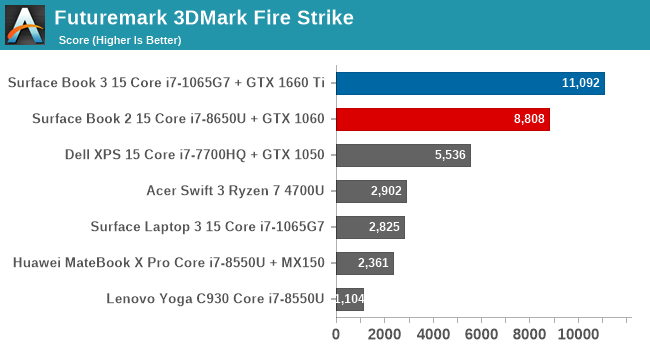
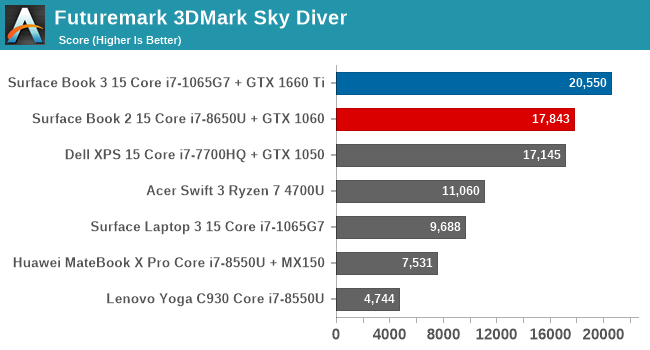
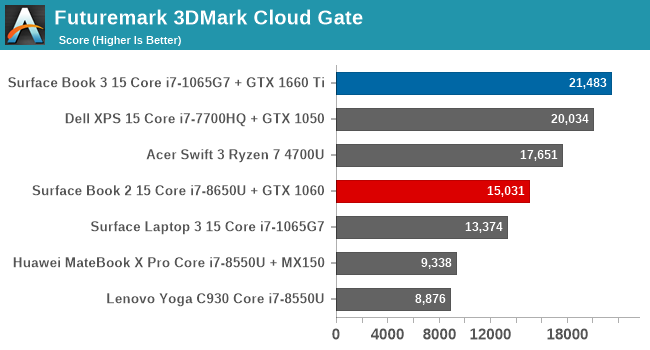
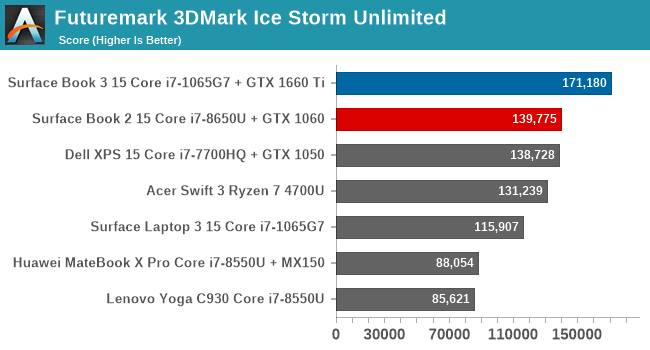

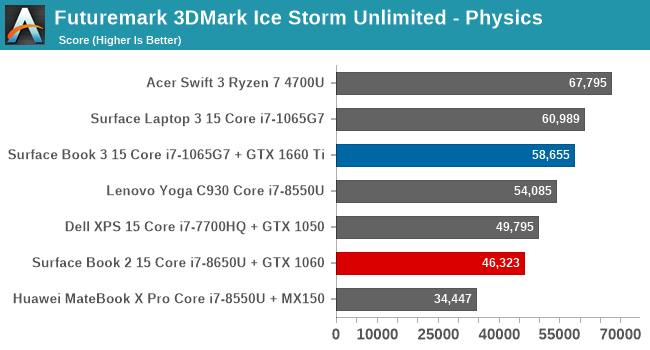
UL’s 3DMark tests a couple of different scenarios, from the very complex Fire Strike down to Ice Storm Unlimited which can be run on smartphones. As the scenes get less complex, the CPU becomes more of a bottleneck. The new CPU and GPU offer a significant increase in performance over the outgoing model.
GFXBench
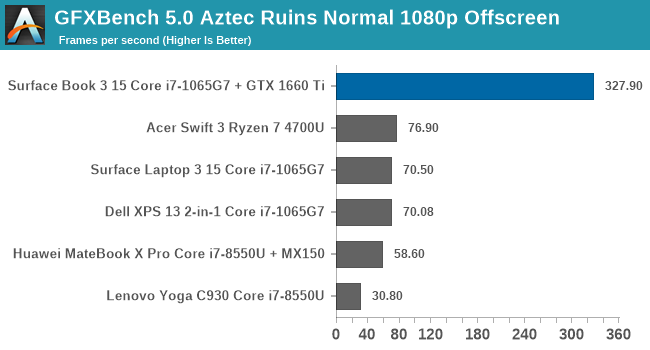
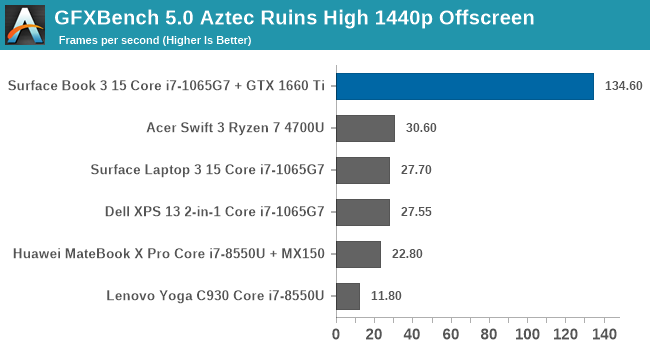
Kishonti’s GFXBench started offering DirectX 12 rendered tests with version 5.0 and instantly made it relevant again. The GTX 1660 Ti handles these tests with aplomb.
Tomb Raider

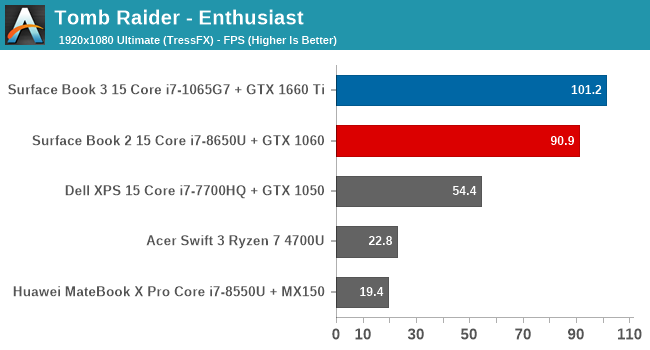
The original Tomb Raider game can be a challenge for devices with integrated GPUs, although the latest AMD Vega and Intel Iris Plus integrated GPUs have come a long way. On Value settings, the old Surface Book 2 was actually slightly ahead, but the Enthusiast level puts things back in the right order.
Rise of the Tomb Raider


The Tomb Raider sequel added DirectX 12 support and added a lot more visual fidelity, and as such the game is much more demanding. The new Surface Book 3 shows a big jump here.
Shadow of the Tomb Raider


The latest in the franchise is even more demanding. Interestingly the benchmark also shows how often the scene was GPU bound. On the Value settings, it was GPU bound only 8% of the time (and therefore 92% of the time it was CPU bound) but once the settings were turned up to 1920x1080 Highest plus TAA, the Surface Book 3 was GPU bound 93% of the test run.
Civilization VI
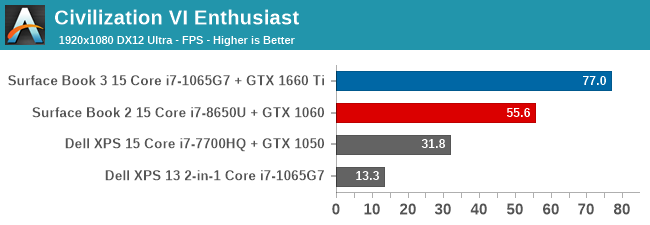
Once again, the Surface Book 3 shows a significant jump over the outgoing model.
Far Cry 5


Far Cry 5 is at the limits of what integrated GPUs can achieve right now, but the Surface Book 3 handles this game very well.
F1 2019


Codemasters’ F1 2019 is also playable on integrated graphics, but much more playable on the Surface Book 3.
GPU Conclusion
The NVIDIA GTX 1660 Ti, even in the Max-Q configuration as in this notebook, offers far more performance than the outgoing GTX 1060. The Surface Book 3 is not a “gaming laptop” by any means, but it certainly has the required chops to be used for gaming when needed. The integrated Xbox wireless for connecting a controller is also a perk, and a perk only found on the 15-inch version. The only downside is that the Surface Book’s 3:2 display can be a problem if the game is expecting 16:9, so your mileage may vary.
If you have a GPU-based productivity task though, the Surface Book 3 offers far more performance than other similar devices. The GTX 1660 Ti offers 50% more CUDA Cores than a GTX 1650 Ti. The Surface Book is somewhat compromised on CPU due to the CPU having to be behind the display, but the extra thermal capacity available by separating the heat loads sure lets them stuff a big GPU in the base.


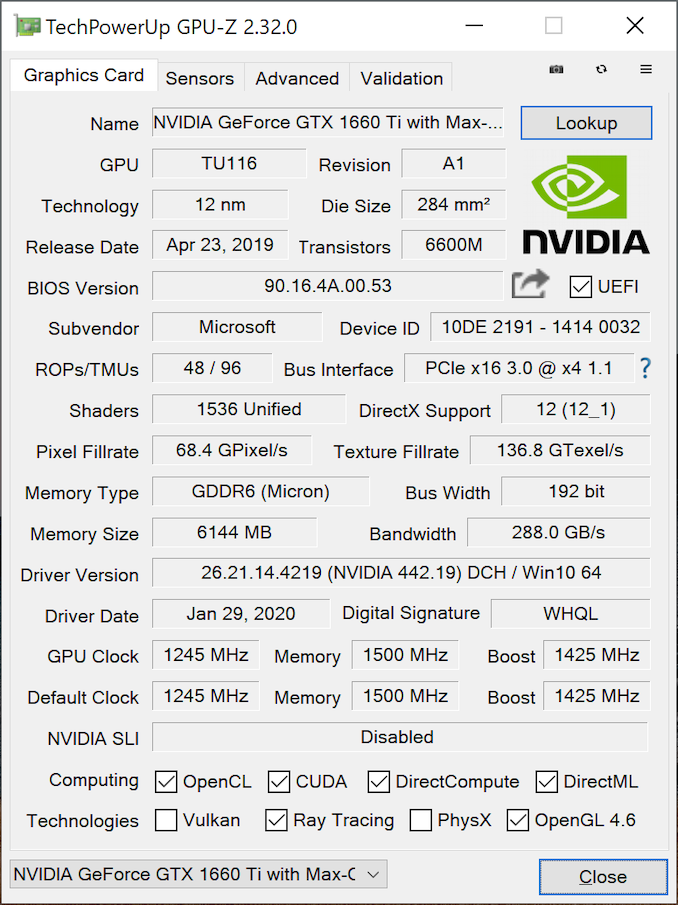








125 Comments
View All Comments
Icehawk - Wednesday, June 3, 2020 - link
And don’t forget if they drain the battery you can’t plug them into a dock to turn it on, you need to use a standalone charger to get it up to 10% or so first. Ugh I am not a Surface fan AT ALL. I’ve supported almost all of the models.pjcamp - Wednesday, June 3, 2020 - link
I don't give a crap about bezels and I doubt anyone else does either, beyond tech pundits and reviewers who need something trendy to criticize. In fact, for devices to be held in the hands, like phones and tablets, bezels are a feature, not a bug, as they limit accidental activations.I own an original Surface Book, and I have a few observations about its durability.
In the end, the detachable form factor is not a good idea. It means if you want to get inside, you have to pry off the screen, a dicey proposition. It is fussy and fumbly to switch back and forth, which you really need to do if you need to change between drawing and typing as drawing in laptop mode is made quite difficult by the screen wobbling back and forth. It's best to think of this as a pure laptop.
The build quality is suspect. I've actually owned three of these things due to warranty replacements. Each of the previous ones had a power button that got stuck in the on position.
Also, I don't detach the screen very much, but the connection on all three computers became wonky. Suddenly it no longer sees the keyboard any more and announces that it is in tablet mode.
The memory wire attachment mechanism is clever, but it has gotten to the point that it doesn't work consistently. And the only recourse then is to find the one and only vent hole on the side that allows you to push a paper clip in at a 45 degree angle to force a manual release. That is clearly designed to prevent you from using it.
Batteries are not eternal but at this point my battery life with keyboard attached is down to less than two hours. That seems like an awfully quick degradation, as these things go.
The only thing that is an unmitigated good about these device, and it is a big thing, is the hi res 3:2 screen. If only Microsoft could make Windows scale appropriately instead of relying on each app to do it independently.
Spunjji - Thursday, June 4, 2020 - link
This pretty much summarises my understanding of the devices, from a support perspective... they're just fussy. Over-engineered would be another way of putting it. Impossible to repair, fragile, and generally not suited to regular use "in anger".A damn shame, really, as I like the concept.
Deicidium369 - Friday, June 5, 2020 - link
I am not sure about them being fragile - have had 10 or 11 deployed in the field, and they can at times take a beating - no failures in ~2 years - I have had my older model for going on 4, although doesn't get used that much anymore... still no issues.Spunjji - Friday, June 5, 2020 - link
Your ~11 beats my 2, but of those 2 both failed - and one had intermittent GPU driver issues even when it was working.amb9800 - Wednesday, June 3, 2020 - link
The GTX 1660 Ti Max-Q seems to be delivering better performance than expected (especially given it's a 65W part, vs. the 80W GTX 1060 Max-P in the Surface Book 2 15"), so it's not a completely worthless spec bump.That said, this would've been the perfect use case for the Ryzen 4000 U-series CPUs. Equipping the Surface Book 3 with a Ryzen 7 4800U would've allowed for performance on par with 45W 6/8-core Intel-based 15" competitors but within the Surface's 15-25W TDP budget.
Intel Ice Lake U-series is by far the biggest disappointment on this machine -- it (along with every other premium Intel-powered ultrabook) gets destroyed by the 4700U-powered $650 Acer Swift 3. The performance picture gets even worse when you look at, say, the Asus ROG Zephyrus G14, which ups the ante with the desktop-killing Ryzen 9 4900HS for under $1,500 -- with a 14" screen, solid battery life, and lower weight than even the 13" Surface Book 3.
lmcd - Thursday, June 4, 2020 - link
It's completely idiotic to compare a part that fits in a tablet form factor with a laptop sporting a 35W CPU. Whether the form factor is dumb or not is a different question.Worth remembering that Intel has delivered a "true SoC" platform for quite some time now. AMD's past CPUs, by comparison, weren't "true SoC" platforms and weren't even candidates to fit on this size of board. Ryzen 2x00U had an idle power bug across the platform, further removing it from candidacy.
That means the first AMD SoC the Surface Book team might've had the chance to integrate is the 3x00U. Based on how long it took for MS to integrate Ice Lake, the Surface Book 3 wouldn't get the 4700U until Christmas or later. Possibly longer considering that the 4700U is a more substantial change than Ice Lake vs past Intel SoCs.
lmcd - Thursday, June 4, 2020 - link
Yea just found this from the Renoir intro:"AMD’s latest Ryzen mobile product is the first design the company has done that combines CPU, GPU, and IO all on a monolithic die in TSMC’s 7nm process."
Indicating that IO wasn't entirely on-board before. Surface Book 4 could theoretically have a Ryzen design.
Deicidium369 - Friday, June 5, 2020 - link
Would imagine that the 1 AMD design they have would be sporting the 4000 series - wonder how much of a new design was needed to support it. Thermals would be better on the 4000 vs the older designSpunjji - Friday, June 5, 2020 - link
I think you've misinterpreted that - Renoir is the first AMD SoC that combines all of that *on 7nm*. I'm fairly sure Raven ridge included USB, SATA etc on-die - that's how the A300 Promontory "chipset" in the ASRock A300 does its thing.Wouldn't surprise me if the SoC had a larger package area than the Intel competitors, though. Intel have been working hard on that aspect for a few generations now.